How to Bridge USDC to Arbitrum: A Step-by-Step Guide for Crypto Bridging
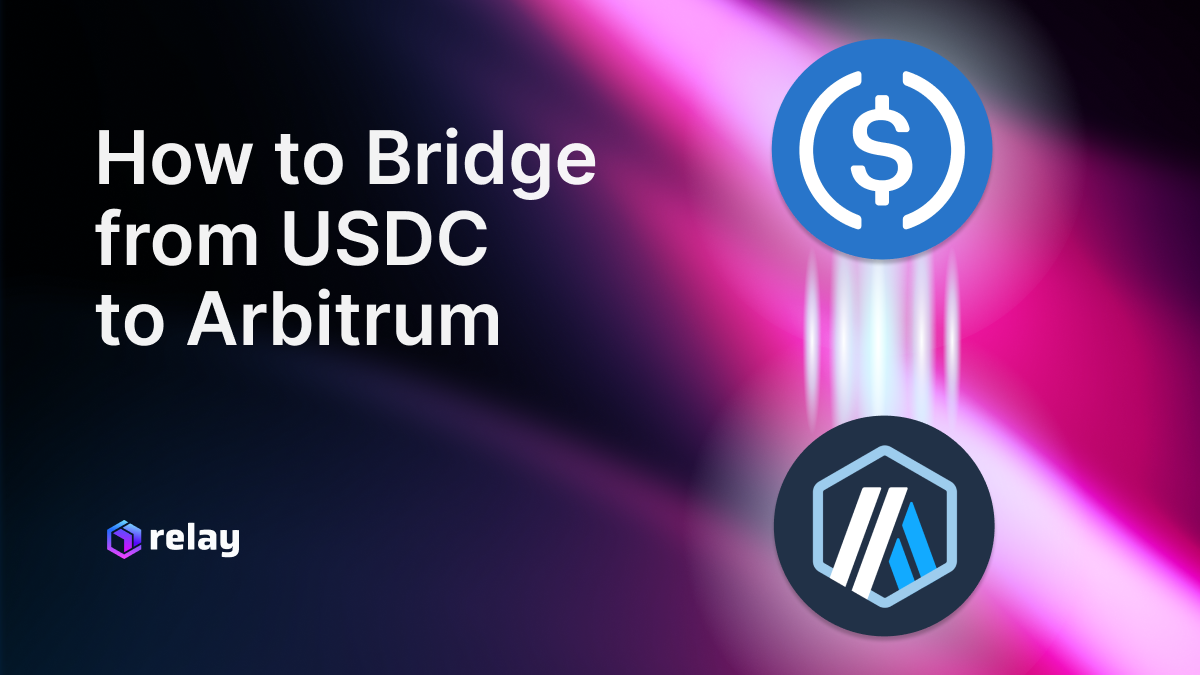
As the crypto ecosystem becomes increasingly multi-chain, the ability to move assets seamlessly between networks is no longer a nice-to-have — it's essential. Whether you're chasing DeFi yields, managing risk, or optimizing for gas fees, crypto bridging allows users to unlock new opportunities across blockchains.
One of the most frequently bridged assets is USDC, a widely-used stablecoin known for its reliability and liquidity. Many users choose to bridge USDC to Arbitrum, Ethereum’s leading Layer 2 scaling solution, to take advantage of its ultra-low fees and rapid transaction speeds.
By using a cross chain swap, USDC holders can move funds efficiently from Layer 1 or other chains directly into the Arbitrum ecosystem — no manual wrapping, no technical friction, just fast and cost-effective movement of capital. This opens the door to powerful DeFi platforms, lower costs, and better control over how and where your crypto works for you.
Why Bridge USDC to Arbitrum?
If you’re holding USDC on Ethereum or another Layer 1 chain, moving it to Arbitrum can significantly enhance your on-chain experience. When you use the Arbitrum bridge, you are specifically bridging your assets to the Arbitrum One network. The bridge leverages blockchain technology to enable secure and efficient transfers between chains. Here’s why so many users choose to bridge USDC to Arbitrum for secure transactions and improved user experience:

🏗️ Introduction to Arbitrum
Arbitrum is a cutting-edge layer 2 scaling solution designed to enhance the Ethereum network by enabling secure, low-fee transactions for decentralized applications (dApps) and users. Utilizing advanced Optimistic Rollup technology, Arbitrum processes transactions off-chain before settling them on Ethereum, dramatically increasing throughput and reducing costs.
The arbitrum bridge is a vital component of this ecosystem, allowing users to transfer assets like USDC seamlessly between Ethereum Mainnet and Arbitrum. This bridge ensures that users can move their assets quickly and securely, taking full advantage of Arbitrum’s speed and affordability while maintaining the robust security of the underlying Ethereum network. By leveraging the arbitrum bridge, users can enjoy a streamlined experience, unlocking new possibilities for efficient and cost-effective transactions across the network.
🔍 Understanding USDC and the Arbitrum Bridge
USDC is a regulated digital currency that stands out for its reliability and transparency. Each USDC token is backed 1:1 by highly liquid cash and cash equivalent assets, including short dated US Treasuries and treasury repurchase agreements, ensuring a steady value pegged to the US dollar.
This makes USDC an ideal choice for users seeking a stable, low-volatility digital asset. The arbitrum bridge enables the secure transfer of USDC between Ethereum Mainnet and Arbitrum, allowing users to access deep liquidity and a wide array of decentralized finance (DeFi) apps.
By bridging USDC, users benefit from low fees, robust security, and the ability to participate in innovative DeFi opportunities on Arbitrum. Whether you’re looking to trade, lend, or provide liquidity, the combination of USDC’s stability and the arbitrum bridge’s efficiency empowers users to make the most of their digital assets in a secure and cost-effective way.
🌍 Global Network and Accessibility
The Arbitrum network is built for global accessibility, making it easy for users from around the world to participate in the digital economy. By connecting their digital wallets, users can bridge assets like USDC and interact with a diverse range of DeFi apps and services. Arbitrum’s support for multiple blockchain networks—including Ethereum, Polygon PoS, and OP Mainnet—means users can seamlessly transfer assets and manage their portfolios across different chains.
The network’s intuitive interface and consistently low fees make it simple for anyone to bridge assets, access liquidity, and take advantage of decentralized finance opportunities. With Arbitrum, users gain the flexibility to manage their digital assets securely and efficiently, no matter where they are in the world.
💸 Lower Transaction Fees
Arbitrum dramatically reduces gas costs compared to Ethereum Mainnet. By moving USDC to Arbitrum, you can transact, trade, and farm without worrying about high fees eating into your capital.
⚡ Faster Transaction Times
Arbitrum’s Layer 2 technology batches and compresses transactions, enabling near-instant confirmations. This makes it ideal for traders and DeFi users who need speed and efficiency.
🌐 Access to Arbitrum-Native DeFi Apps
The Arbitrum DeFi ecosystem is rapidly expanding. Bridging USDC unlocks access to powerful platforms like:
- GMX – Decentralized perpetuals trading
- Camelot – Arbitrum-native DEX
- Radiant Capital – Cross-chain lending protocol
After bridging, users can interact with a variety of tokens, including USDC, ETH, and other ERC-20 tokens on these platforms. You can spend your USDC and other tokens for trading, lending, and a range of DeFi activities across the Arbitrum ecosystem.
🌱 Yield Farming & Liquidity Provision
With USDC on Arbitrum, you can tap into high-yield opportunities across DEXs, lending protocols, and LP pools — often with better ROI than on Layer 1 due to lower costs and higher activity.
In short, when you bridge USDC to Arbitrum, you’re not just moving funds — you’re gaining access to a fast, affordable, and DeFi-rich ecosystem. Bridging USDC to Arbitrum also allows users to diversify and manage their DeFi portfolio more efficiently.
🚀 Developer Opportunities on Arbitrum
For developers, Arbitrum offers a powerful platform to build and deploy scalable, secure, and cost-effective applications. Thanks to its EVM-compatible architecture, developers can easily migrate existing Ethereum-based projects or launch new ones, all while benefiting from Arbitrum’s low fees and high security.
The arbitrum bridge streamlines the process of transferring assets like USDC between Ethereum Mainnet and Arbitrum, providing developers with access to greater liquidity and a broader user base. With robust developer tools, comprehensive documentation, and an active community, Arbitrum empowers developers to innovate and create next-generation DeFi apps and services. Whether you’re building for finance, gaming, or any other sector, Arbitrum’s network and bridge infrastructure offer the security, efficiency, and flexibility needed to succeed.
🌎 Real-World Impact of Bridged USDC
Bridging USDC to Arbitrum is transforming access to financial services on a global scale. By enabling secure, low-cost transfers of a stable, regulated digital currency, the arbitrum bridge opens the door for millions of users to participate in decentralized finance (DeFi) apps and services—such as lending, borrowing, and trading—across multiple blockchain networks like Polygon PoS and OP Mainnet.
This increased accessibility supports greater financial inclusion, allowing users worldwide to manage their assets, access liquidity, and explore new economic opportunities. The ability to bridge USDC securely and efficiently not only enhances the utility of digital dollars but also strengthens the global network of decentralized finance, making it easier for users everywhere to benefit from the evolving digital economy.

What You Need Before You Start
Before you complete a cross chain swap to move your USDC to Arbitrum, it’s important to get your setup right. You may need to switch your wallet network to Arbitrum before starting the bridging process. For example, in MetaMask, you can switch to the Arbitrum network from the network dropdown. Here’s what you’ll need to ensure a smooth, secure bridging experience:
💼 1. USDC on Your Source Chain
Make sure you have a sufficient USDC balance on the chain you’re bridging from — commonly Ethereum, Polygon, or another EVM-compatible network.
🔐 2. A Compatible Crypto Wallet
You’ll need a crypto wallet for bridging that supports dApp interactions. MetaMask is the most widely used, but wallets that use WalletConnect (e.g., Trust Wallet, Rainbow) also work seamlessly.
⛽ 3. ETH on Arbitrum for Gas Fees
Once you bridge USDC to Arbitrum, you'll need a small amount of ETH in your Arbitrum wallet to cover gas costs for future transactions. You can bridge ETH to Arbitrum separately if needed.
🌉 4. A Trusted Crypto Bridging Platform
Use a reliable and efficient crypto bridging tool. Relay is built specifically for fast, low-cost cross chain swaps — allowing you to bridge USDC directly from one chain to another without unnecessary steps or risks.
Getting these essentials in place ensures your swap is smooth, fast, and safe — so you can start using your USDC in the Arbitrum DeFi ecosystem right away.
Step-by-Step Guide: How to Bridge USDC to Arbitrum
Ready to move your stablecoins into Arbitrum’s low-fee DeFi ecosystem? Before bridging, you can acquire USDC on major exchanges, which provide liquidity for USDC on various chains. Follow these simple steps to complete a cross chain swap using a trusted crypto bridging platform like Relay.
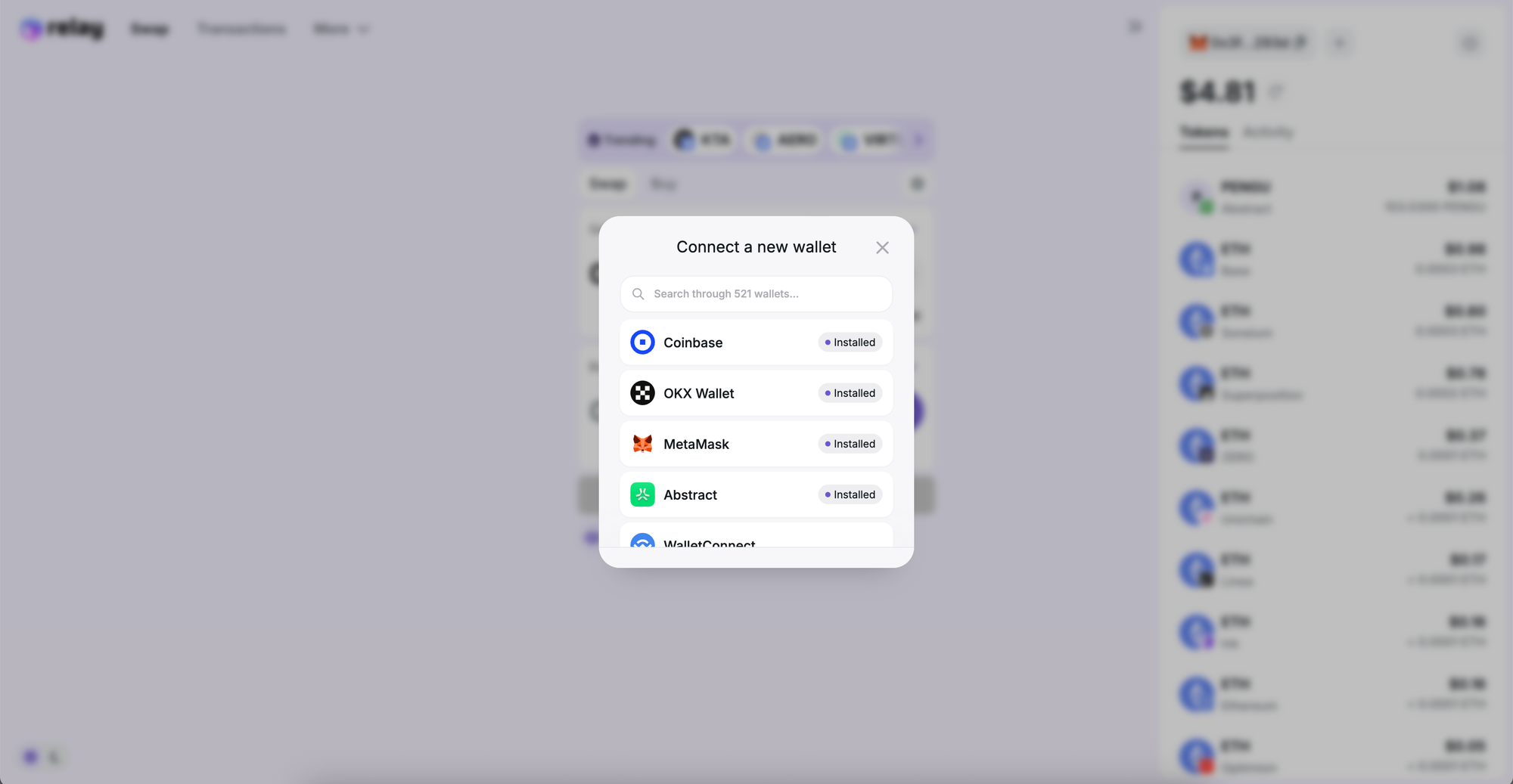
🪙 Step 1: Connect Your Wallet
Visit Relay.link and click “Connect Wallet.” Choose your preferred crypto wallet for bridging — most users opt for MetaMask, but WalletConnect-compatible wallets work as well. Approve the connection to allow Relay to view your balances and interact with the network.
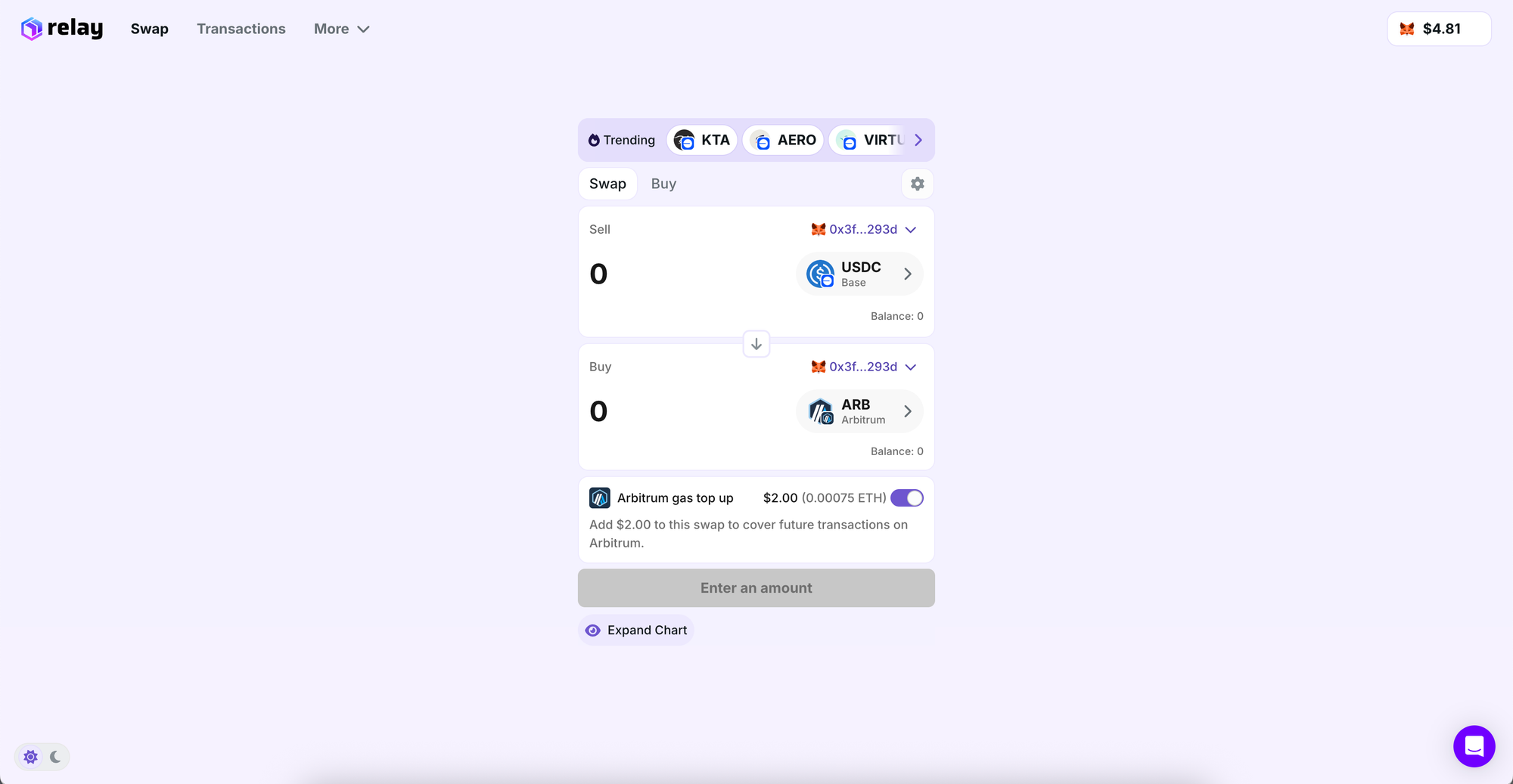
🌐 Step 2: Select the Source Chain and Token
Choose your source chain (e.g., Ethereum, Polygon, or Avalanche) and select USDC as the token you want to bridge. Relay will automatically detect your balance.
🧭 Step 3: Set Arbitrum as the Destination Chain
From the dropdown menu, select Arbitrum as the destination. You’ll see an estimated arrival amount based on network conditions and fees.
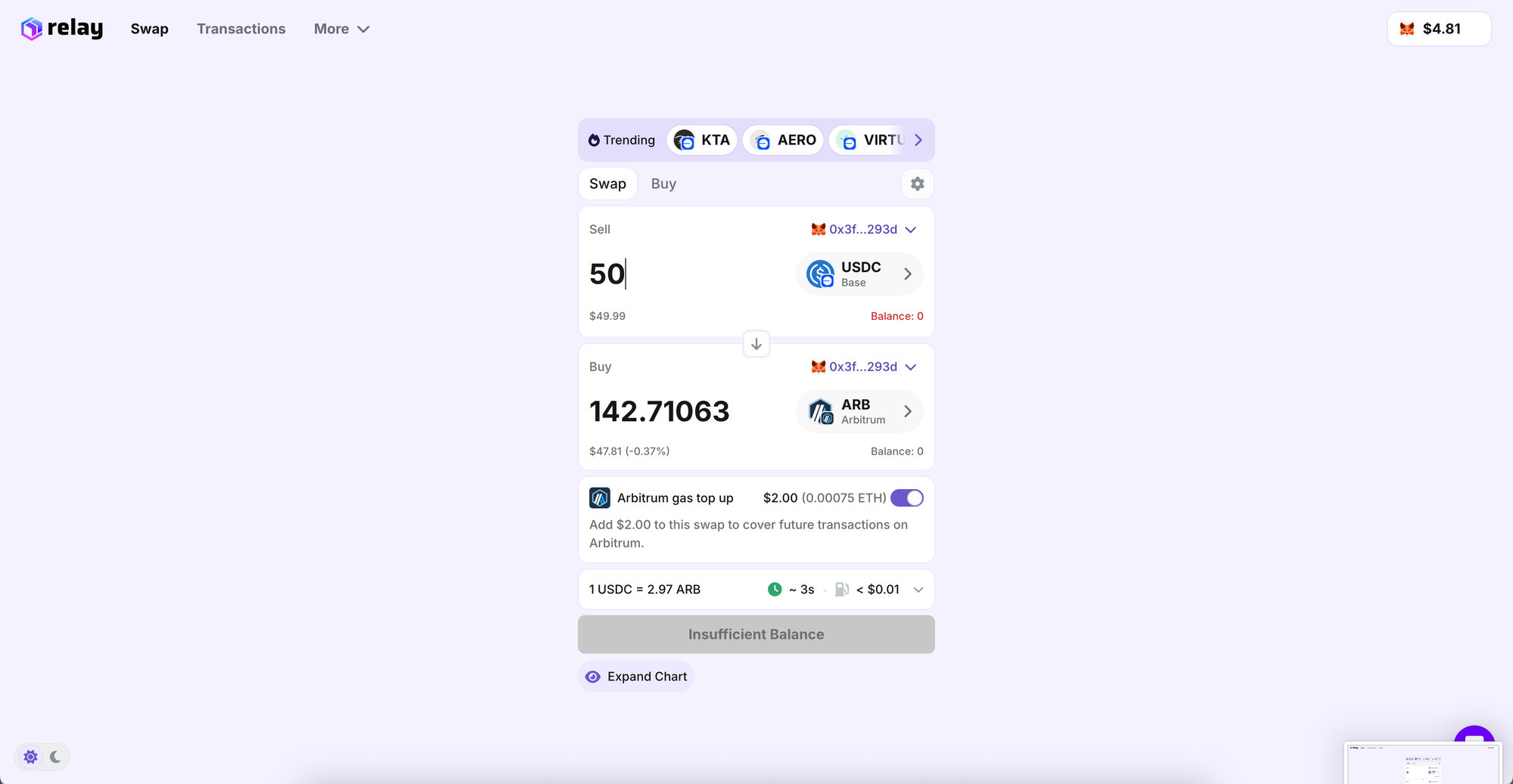
✅ Step 4: Approve & Initiate the Cross Chain Swap
Click “Approve” to allow Relay access to your USDC. Once approved, hit “Swap” or “Bridge” to start the transaction. Confirm the action in your wallet when prompted.
🔍 Step 5: Wait for Confirmation and Verify
The bridging process usually completes within a few minutes. You can monitor progress directly on Relay or confirm receipt of USDC by checking your wallet or viewing your address on Arbiscan.
Once confirmed, your USDC is now live on Arbitrum — ready to use across its growing DeFi ecosystem!
Tips for Safe and Efficient Bridging
When moving assets across chains, a few smart precautions can save you from costly mistakes. Bridging stablecoins like USDC, which are issued by regulated financial institutions, adds an extra layer of trust and security to your transactions. Banks play a key role in supporting USDC liquidity and redemption processes, ensuring seamless movement of money between traditional finance and blockchain networks.
Bridging USDC allows users to move money efficiently across blockchain networks, making transfers faster and more reliable. This process is transforming global finance by enabling more efficient and inclusive cross-border transactions. Follow these best practices for safe crypto bridging and smoother transactions:
🔁 Double-Check Destination Details
Always confirm you’ve selected the correct destination chain and wallet address. Bridging to the wrong network or wallet can result in permanent loss of funds. Most platforms like Relay will auto-fill verified networks, but it’s worth double-checking before confirming the cross chain swap.
⛽ Be Aware of Gas Fees
While Arbitrum is significantly cheaper than Ethereum mainnet, you may still need ETH to cover transaction fees — both on the source and destination chains. Keep a small ETH balance on Arbitrum to avoid getting stuck without gas after bridging.
✅ Use Verified Platforms Only
Stick to reputable crypto bridging tools with a strong track record. Relay is a trusted option for safe crypto bridging, with support for stablecoins like USDC and real-time routing across multiple chains.
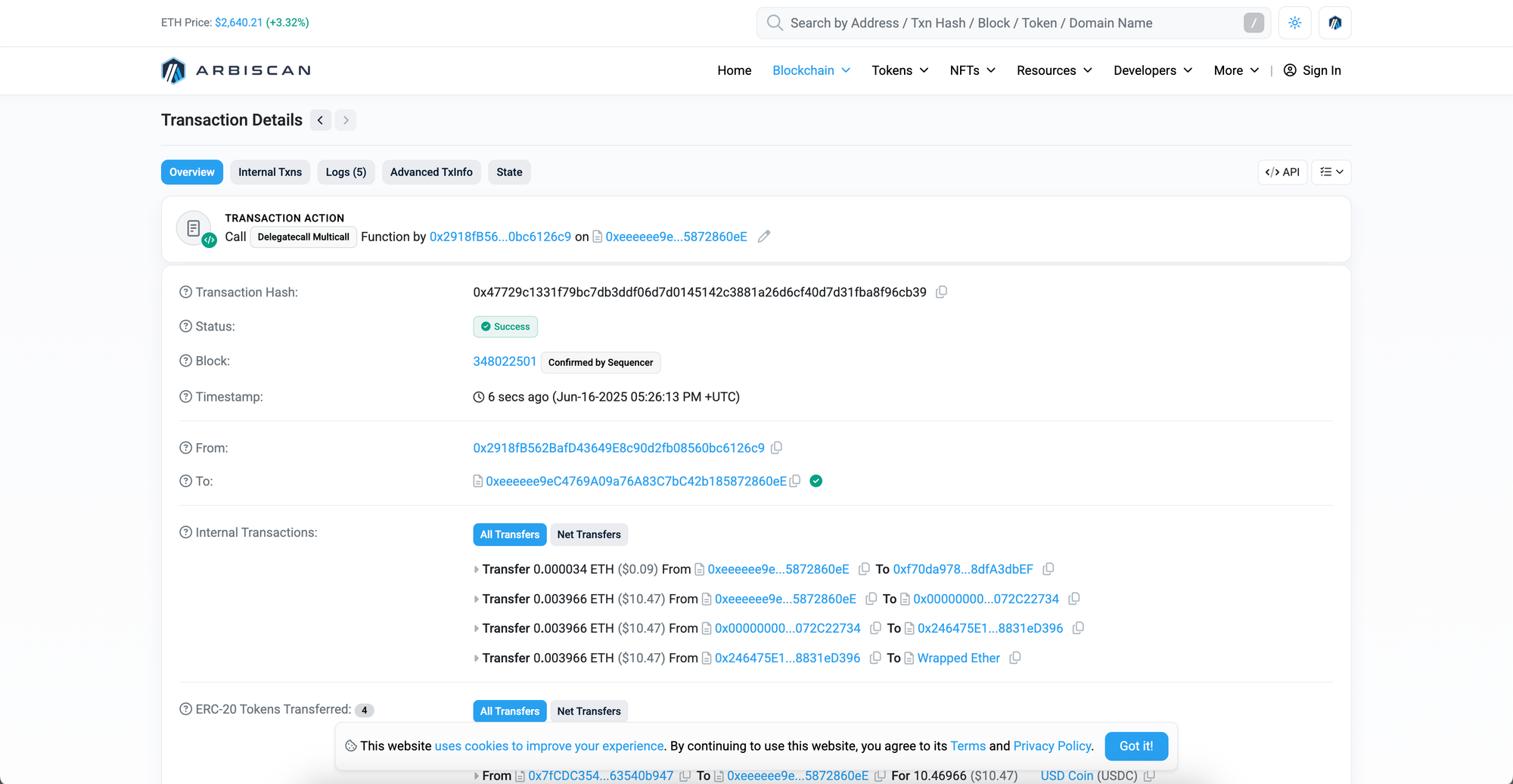
🔍 Confirm Arrival via Arbiscan
After bridging, verify your USDC has arrived by checking your wallet balance or viewing your transaction on Arbiscan. This explorer shows the complete transaction history and ensures your funds landed on the correct chain.
Common FAQs
Have questions about moving your USDC across chains? Below are answers to some of the most frequent crypto bridging questions, especially when using platforms like Relay for a USDC cross chain swap to Arbitrum.
⏱️ How long does it take to bridge USDC to Arbitrum?
Most cross chain swaps complete within 1–5 minutes, depending on network congestion and the bridging platform. Relay is optimized for speed and typically finalizes USDC transfers quickly.
🔒 Is bridging USDC safe?
Yes — if you use a verified crypto bridging platform like Relay, the process is secure. Always double-check network selections and wallet addresses to minimize risks. For extra security, verify final transactions via Arbiscan.
🔁 Can I reverse a cross chain swap?
No. Once a cross chain swap is confirmed and executed, it cannot be reversed. Always review the transaction details carefully before approving in your wallet.
💸 What fees are involved in crypto bridging?
You’ll typically pay two fees:
- A gas fee on the source chain (e.g., Ethereum)
- A bridge fee charged by the platform — usually around 0.1%–0.3% of the transaction
Relay keeps fees transparent and competitively low, making it a top choice for cost-effective crypto bridging.
Conclusion
As the DeFi landscape becomes increasingly multi-chain, knowing how to bridge USDC to Arbitrum is a must-have skill for active users looking to optimize performance, reduce costs, and access high-yield opportunities. With lower gas fees, faster transactions, and a thriving ecosystem of protocols, Arbitrum is one of the most attractive Layer 2 destinations for stablecoin holders today.
USDC is issued by Circle, a regulated and reputable company at the forefront of digital currency innovation. The majority of USDC reserves are held in the Circle Reserve Fund, an SEC-registered money market fund, ensuring transparency and regulatory compliance. An independent accounting firm, specifically a Big Four accounting firm, provides monthly attestations of USDC reserves, verifying that every token is fully backed and reinforcing trust in the stablecoin. USDC's large circulation across multiple blockchain networks further demonstrates its liquidity, transparency, and trustworthiness.
Using a seamless, user-friendly tool like Relay makes the entire process of crypto bridging simple and efficient. With just a few clicks, you can execute a secure cross chain swap, moving your assets from networks like Ethereum or Polygon directly into Arbitrum — no technical setup required.
Whether you’re yield farming, trading, or just exploring the Arbitrum DeFi ecosystem, bridging your USDC is the first step to unlocking new opportunities.
👉 Start your USDC cross chain swap on Relay and experience frictionless DeFi across chains.
